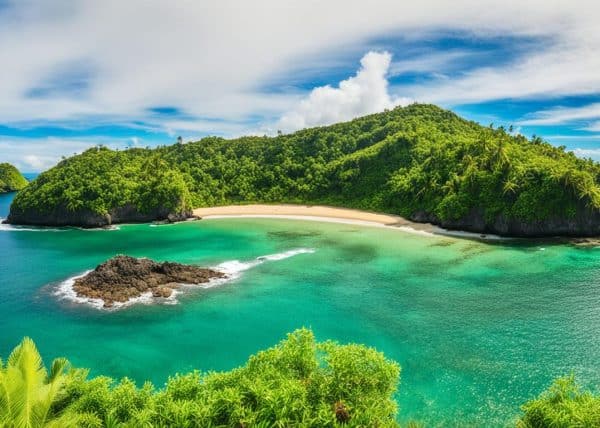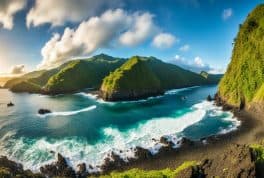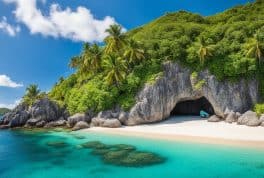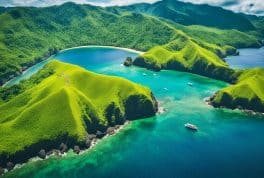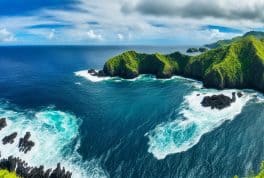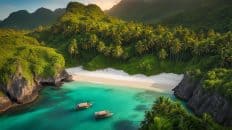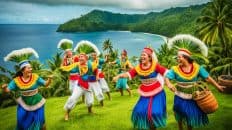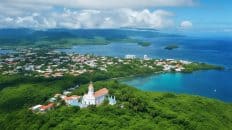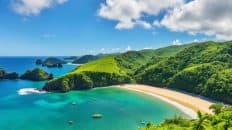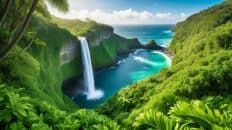Catanduanes Island
Catanduanes, known as the "Happy Island" in the Philippines, is a haven of natural beauty with pristine beaches, lush landscapes, and excellent surfing spots like Puraran Beach. Its rich culture, historical landmarks, and warm hospitality make it a perfect destination for a serene yet adventurous getaway.
Top 10 Things to see in Catanduanes
- Puraran Beach: Known for its majestic waves, Puraran Beach is a haven for surfers. The beach's stunning landscape, characterized by its golden sand and crystal-clear waters, makes it a perfect spot for relaxation and surfing enthusiasts.
- Binurong Point: Offering panoramic views of the Pacific Ocean, Binurong Point is a must-visit for nature lovers. The trek to the point takes you through beautiful landscapes, and the view from the top is breathtaking.
- Bato Church: As one of the oldest and most historically significant structures in Catanduanes, Bato Church is a magnificent example of colonial-era architecture and a testament to the island's rich history.
- Twin Rock Beach Resort: A popular destination for both locals and tourists, this resort features beautiful beaches, clear waters, and rock formations. It's an ideal place for swimming, snorkeling, and enjoying the natural beauty of Catanduanes.
- Maribina Falls: Located near Bato, Maribina Falls is renowned for its cascading waters and natural pools. It's a refreshing retreat for those looking to escape the tropical heat.
- Balacay Point: Another scenic spot offering stunning views of Catanduanes’ rugged coastline. The journey to Balacay Point is an adventure in itself, with lush greenery and rolling hills along the way.
- Luyang Cave Park: Not just a natural wonder, Luyang Cave has historical significance as well. The park surrounding the cave offers lush scenery and a peaceful environment for visitors.
- Museo de Catanduanes: To learn about the rich history and culture of the island, a visit to Museo de Catanduanes is essential. The museum showcases artifacts, historical documents, and exhibits that tell the story of the island.
- Amenia Beach: A less crowded alternative for beach lovers, Amenia Beach offers serene beauty, clear waters, and a relaxing atmosphere, perfect for those seeking a more peaceful beach experience.
- Catanduanes Provincial Capitol: Located in Virac, the capital of Catanduanes, the Provincial Capitol is not only a government building but also a symbol of the island's progress and development. The surrounding areas are well-kept and offer a pleasant environment for a stroll.
Guides and Tours
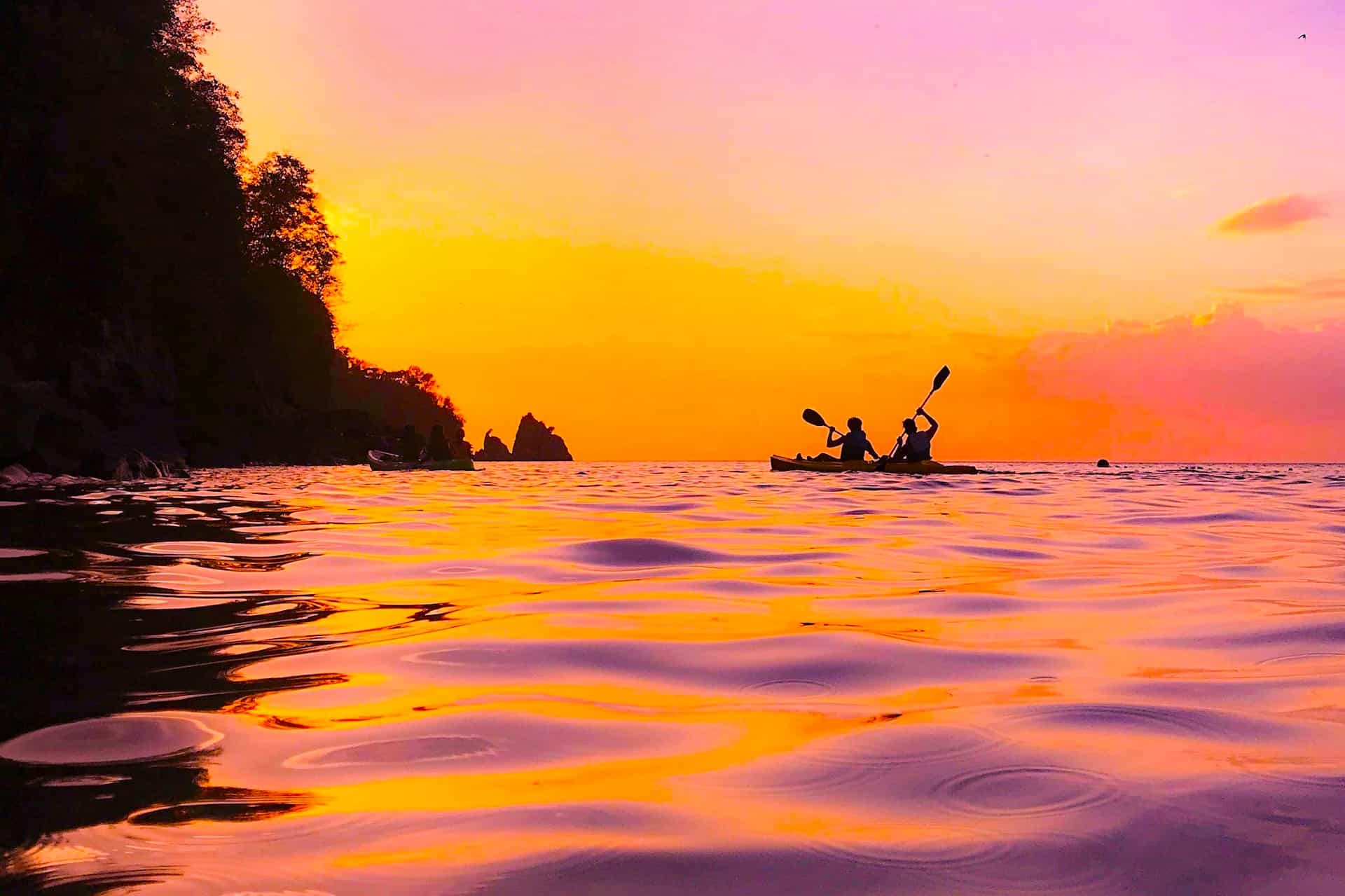
Top 10 Questions and Answers about Catanduanes
- What is Catanduanes known for?
- Catanduanes is known as the "Happy Island" and is famous for its beautiful beaches, surfing spots, particularly Puraran Beach, lush landscapes, and vibrant cultural heritage. It's also noted for its rich biodiversity and serene, natural beauty.
- How do you get to Catanduanes?
- You can get to Catanduanes by air or sea. The most common route is to take a flight to Virac Airport from major cities in the Philippines. Alternatively, you can take a ferry from the Bicol mainland to one of the ports in Catanduanes.
- What are the best tourist spots in Catanduanes?
- The best tourist spots include Puraran Beach for surfing, Binurong Point for its breathtaking views, Maribina Falls, Bato Church for its historical significance, and Twin Rock Beach Resort for leisure and relaxation.
- What is the best time to visit Catanduanes?
- The best time to visit Catanduanes is during the dry season, which is from December to May. This period offers the most favorable weather conditions for outdoor activities and beach visits.
- Is Catanduanes safe for tourists?
- Yes, Catanduanes is generally safe for tourists. However, like any travel destination, it's advisable to take standard safety precautions, be aware of weather conditions, especially during typhoon season, and stay informed about local advisories.
- What activities can tourists do in Catanduanes?
- Tourists can enjoy surfing, beach hopping, snorkeling, trekking to scenic viewpoints like Binurong Point, exploring historical sites like Bato Church, and experiencing local festivals and cultural events.
- What are the local delicacies of Catanduanes?
- Local delicacies in Catanduanes include seafood dishes like crab and lobster, Bicolano specialties such as Bicol Express (spicy pork stew) and Laing (taro leaves in coconut milk), and traditional sweets like latik.
- Can you describe the culture of Catanduanes?
- The culture of Catanduanes is a mix of indigenous traditions and influences from Spanish colonization. It's reflected in the island's festivals, cuisine, crafts like weaving, and the daily lives of its people, who are known for their warmth and hospitality.
- Are there any unique environmental features in Catanduanes?
- Catanduanes boasts unique environmental features such as unspoiled coral reefs, diverse marine life, lush rainforests, and a variety of endemic species. Its geographical location also makes it prone to tropical cyclones, shaping much of its natural landscape.
- What should tourists know before visiting Catanduanes?
- Tourists should be aware of the weather conditions, especially the typhoon season from June to November. It's also important to respect local customs and environmental guidelines, and be prepared for limited internet connectivity in remote areas. Additionally, carrying cash is advisable as ATMs may not be widely available, especially in rural areas.
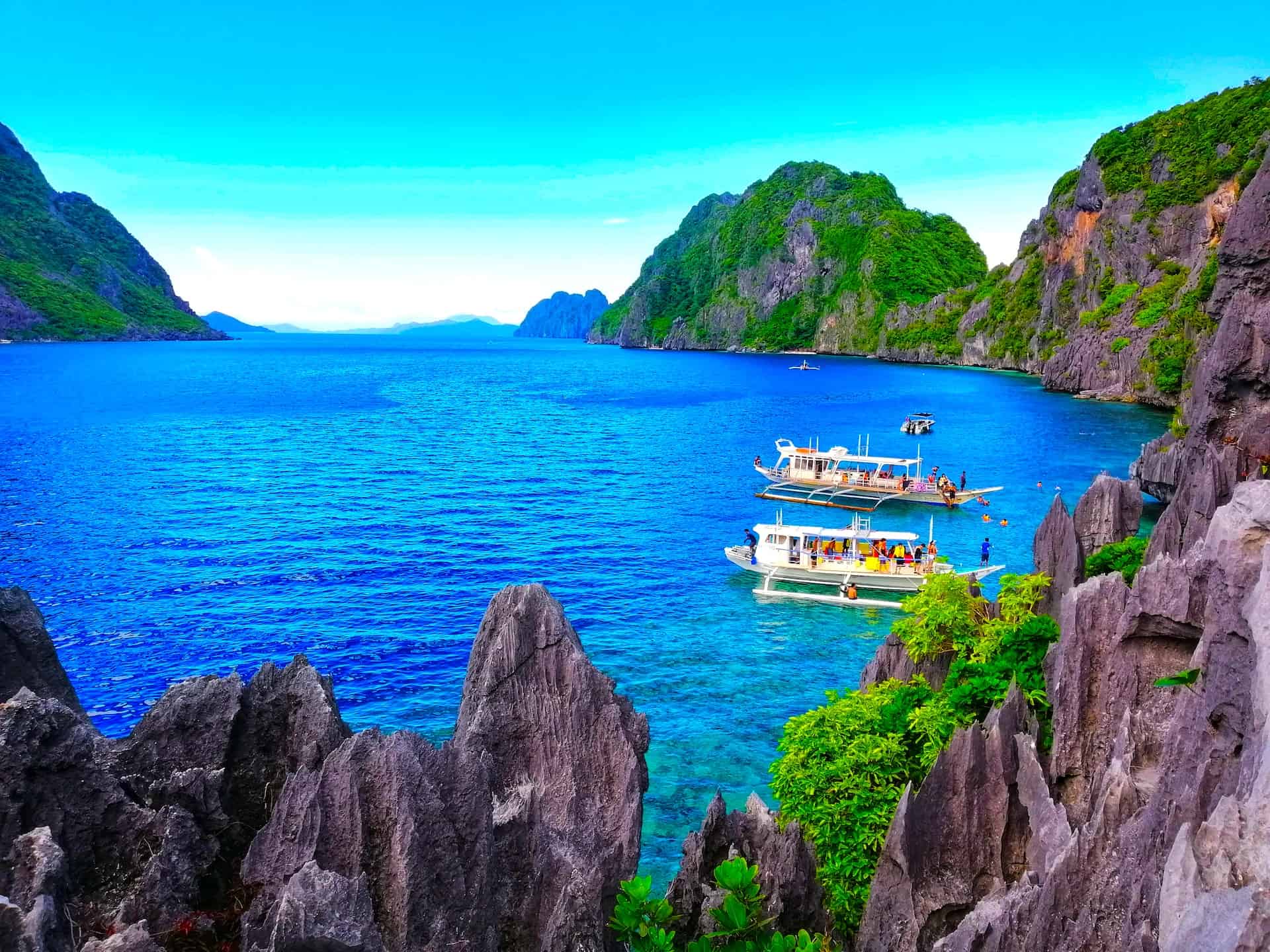
Why you should visit Catanduanes
Discovering the Splendor of Catanduanes Island: A Traveler's Haven
Introduction to the Enchanting Island of Catanduanes
Nestled in the easternmost part of the Bicol Region in the Philippines, Catanduanes, often referred to as the "Happy Island," is a destination that promises an unparalleled blend of natural beauty, cultural richness, and serene escapism. This breathtaking island, with its unspoiled landscapes and warm, welcoming locals, offers a unique experience that captivates every traveler's heart.
The Pristine Beaches of Catanduanes
A Surfing Paradise: Puraran Beach
Catanduanes is a haven for beach lovers and surf enthusiasts. The crown jewel of its coastal offerings is Puraran Beach, known for its majestic waves and golden sands. The beach is not just a surfing hotspot but also a place where one can bask in the sun and enjoy the soothing sounds of the waves. It's an idyllic setting for both adventure seekers and those looking to unwind in nature’s lap.
Serene Shores and Untouched Beauty
Aside from Puraran, Catanduanes boasts a plethora of beaches, each with its unique charm. From the tranquil waters of Mamangal Beach to the secluded coves dotting the island, there’s a stretch of sand for every type of beachgoer. The beaches here are less crowded, offering a serene environment, far from the commercial hustle of popular tourist destinations.
Rich Marine Life and Diving Spots
For snorkelers and divers, Catanduanes’ underwater world is a wonderland. The clear waters and healthy coral reefs are teeming with marine life, offering a vibrant spectacle that is both enchanting and educational.
The Natural Wonders of Catanduanes
Lush Landscapes and Scenic Hikes
The beauty of Catanduanes extends beyond its beaches. The island is adorned with lush greenery, rolling hills, and scenic trails. Hiking to destinations like Binurong Point and Balacay Point rewards travelers with panoramic views that are nothing short of magical. These hikes not only satisfy the thirst for adventure but also provide a deep connection with nature.
Mystical Caves and Waterfalls
Exploring the island leads to discoveries like Luyang Cave Park and Maribina Falls. The cave park, steeped in local legends, and the cascading waters of the falls provide a refreshing retreat and a glimpse into the island’s diverse natural offerings.
The Cultural Fabric of Catanduanes
A Melting Pot of Traditions
The culture of Catanduanes is a vibrant tapestry woven with the threads of history, traditions, and modern influences. The island's festivals, such as the Catandungan Festival, are a riot of color and energy, showcasing traditional dances, music, and culinary delights. These events are not just celebrations but a way for locals to preserve and share their rich heritage.
Historical Landmarks and Museums
For history buffs, landmarks like Bato Church and Museo de Catanduanes offer insights into the island’s past. The architecture and artifacts found here are windows to the island's historical journey and cultural evolution.
The Art of Craftsmanship and Local Cuisine
The craftsmanship of Catanduanes, especially in weaving and pottery, is a testament to the islanders' artistic skills. Additionally, the local cuisine is a delightful exploration of flavors, with seafood and traditional Bicolano dishes offering a culinary adventure.
Why Catanduanes Should Be Your Next Destination
The Road Less Traveled
Catanduanes stands out as a destination for its untouched beauty and the peaceful ambiance it offers. It's a perfect getaway for those who wish to explore the road less traveled and immerse themselves in a genuine, uncommercialized experience.
A Harmony of Nature and Culture
The island beautifully balances its natural offerings with cultural richness. Whether it's lounging on a quiet beach, trekking through lush forests, exploring historical sites, or participating in local festivals, Catanduanes provides a harmonious blend of experiences.
Warm Hospitality and Sustainable Tourism
The warmth and hospitality of the locals in Catanduanes add to its charm. Visitors are greeted with smiles and treated to genuine kindness, making their stay memorable and comfortable. Moreover, the focus on sustainable tourism ensures that the beauty of the island is preserved for future generations.
Accessibility and Convenience
Reaching and exploring Catanduanes is convenient, with regular flights to Virac Airport and ferry services from the mainland. Once on the island, getting around is easy with available public transportation, car rentals, and organized tours.
Conclusion: Embracing the Essence of Catanduanes
In conclusion, Catanduanes is more than just a destination; it's an experience that stays with you long after the journey ends. The island's blend of pristine natural landscapes, rich cultural heritage, and the warmth of its people makes it a must-visit for anyone seeking an authentic and enriching travel experience. Whether you're an adventurer, a culture enthusiast, or just looking for a peaceful retreat, Catanduanes promises a journey that will captivate and delight you in every way. So, pack your bags and set off to explore the unexplored, to embrace the unique and mesmerizing essence of Catanduanes Island.
Getting to Catanduanes
Reaching Catanduanes, an island province in the Philippines, involves a journey by air or sea. The most common route is by air, with flights available to Virac Airport from major cities like Manila. Upon landing, travelers can use local transportation like taxis or tricycles to reach various destinations on the island. Alternatively, sea travel is an option with ferries operating from the Bicol mainland to Catanduanes. These ferry services, which embark from ports such as Tabaco in Albay, offer a scenic sea journey, connecting passengers directly to the towns of Virac, San Andres, or Caramoran in Catanduanes. This blend of air and sea travel options provides flexibility and convenience for visitors heading to this picturesque island.
Top 10 Hotels on Catanduanes
- Happy Island Inn: Offers free WiFi and parking.
- Catanduanes Midtown Inn: Known for its restaurant and free WiFi.
- Emmalyn's Paradise Resort: Features free parking and beach access.
- Casa Remedios Bed & Breakfast
- Majestic Puraran Beach Resort: Offers a beachfront location and a pool.
- ARDCI Corporate Inn: Known for its restaurant and room service.
- Marem Pension House: Provides free WiFi and parking.
- Queen Maricel Inn
- E-Crown Hotel And Resort: Offers free WiFi and parking.
- Titaays Surfers Inn
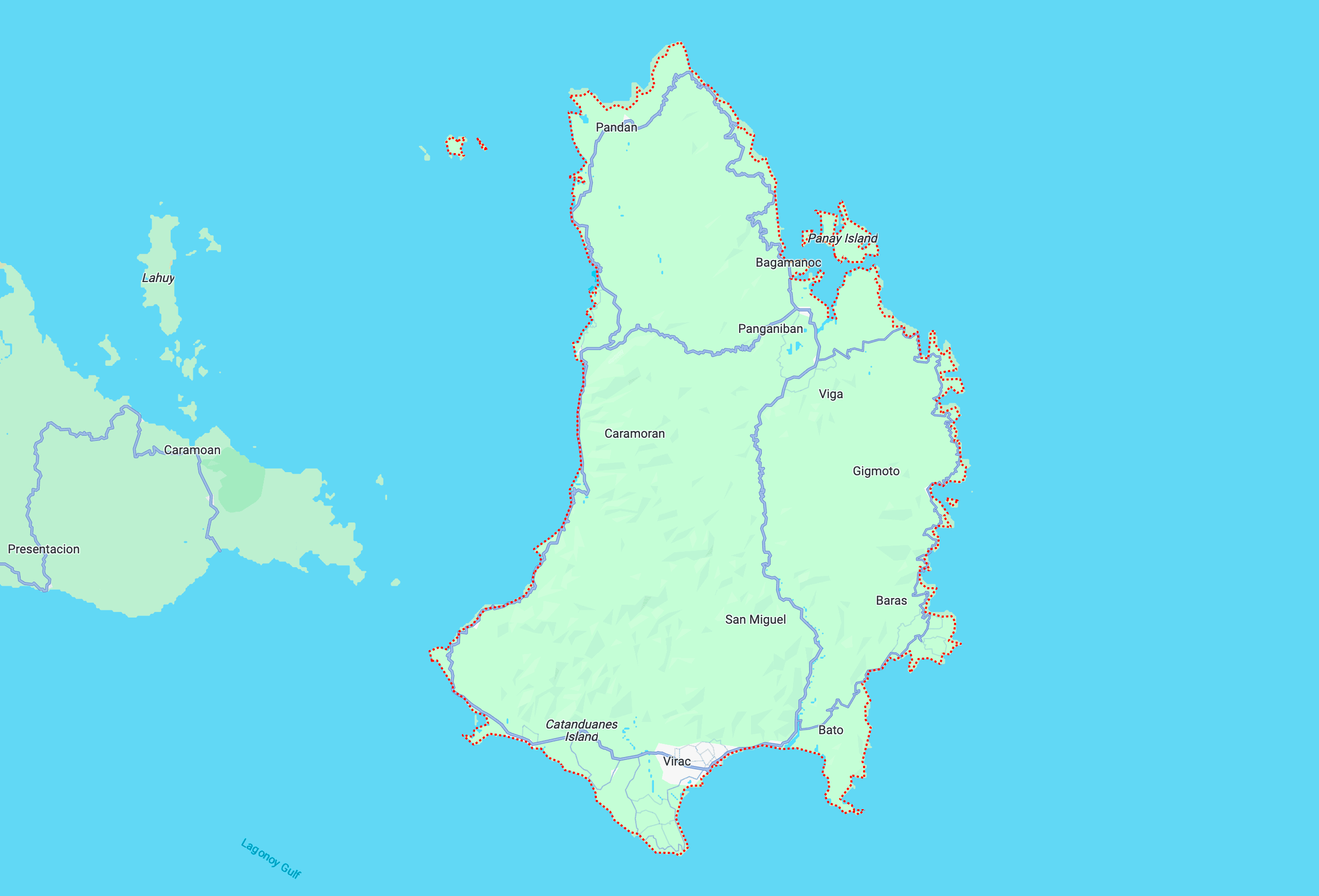
Catanduanes Facts
1: Introduction to Catanduanes - A Hidden Gem in the Pacific
Nestled in the sparkling blue waters of the Pacific Ocean, Catanduanes, a small island province in the Philippines, stands as a testament to the awe-inspiring beauty and resilience nature can bestow. Often referred to as the "Happy Island," Catanduanes captivates visitors with its pristine beaches, lush greenery, and a tranquility that resonates with the soul. This introduction to Catanduanes is more than a mere overview; it is an invitation to explore and experience the unspoiled natural beauty and cultural richness of this remarkable island.
The Geographical Marvel of Catanduanes
Located in the easternmost part of the Bicol Region, Catanduanes is an island province that lies in the Philippine Sea, adjacent to the vast Pacific Ocean. It encompasses an area that radiates natural wonders and scenic landscapes. From its rugged, rocky shorelines to its rolling hills and verdant forests, Catanduanes Island is a geographical marvel. The island's eastern coast faces the Pacific Ocean, receiving the brunt of the ocean's might, which has shaped its character and landscape over millennia.
Catanduanes is not just an island but an archipelago of smaller islands, each contributing to its unique ecosystem. The island's topography is marked by a combination of mountainous terrain and flat, fertile valleys. It is this varied landscape that endows Catanduanes with its distinct charm, making it a paradise for nature lovers and adventurers alike.
Catanduanes: A Journey Through Time
The history of Catanduanes is as colorful as its natural tapestry. The island has been a witness to several key events in Philippine history. Before it was recognized as an independent province, Catanduanes was part of the larger Albay province. Its history is intertwined with the narratives of the southern tribes that first inhabited the island and the subsequent influences from foreign settlers.
During World War II, Catanduanes played a significant role as a strategic location. The island's secluded coves and dense forests provided cover and protection, making it a crucial point in the wartime efforts in the Pacific. The resilience and bravery of its people during these trying times are a source of pride and are celebrated in local lore and annual commemorations.
Post-war, Catanduanes emerged as a small island province, gaining administrative independence and beginning a new chapter in its rich history. This transformation marked a significant milestone for the island, setting the stage for its development and growth in the decades to come.
The Natural Splendor of Catanduanes Island
The natural beauty of Catanduanes is nothing short of breathtaking. The island is a symphony of green - a fusion of lush greenery, cascading waters, and vibrant ecosystems. The forested areas of Catanduanes are a haven for diverse flora and fauna, offering a glimpse into the rich biodiversity of the Philippines.
The beaches of Catanduanes are a highlight of the island's natural attractions. With fine sand and crystal clear waters, these beautiful beaches here, such as Puraran Beach, Mamangal Beach, and the renowned Twin Rock Beach Resort, offer idyllic settings for relaxation and recreation. The beaches here are not just beautiful; they are pristine, preserved in their natural state, away from the bustle of commercial tourism.
Catanduanes is also known for its impressive rock formations. These natural rock formations, sculpted by the howling winds and waves of the Pacific, are a sight to behold. They add to the island's mystique, making it a photographer's and geologist's dream.
Embracing the Title 'Happy Island'
The term "Happy Island" is not just a moniker for Catanduanes; it's a reflection of the island's spirit and the disposition of its people. Despite facing the full force of tropical cyclones and the challenges of island life, the people of Catanduanes have maintained a cheerful and resilient spirit. This positive outlook is infectious, and visitors to the island often comment on the warm and welcoming nature of its residents.
The island's charm lies not only in its natural beauty but also in its ability to inspire a sense of serenity and happiness in those who visit. The combination of stunning views, panoramic landscapes, and the gentle demeanor of the locals makes Catanduanes an ideal retreat from the hectic pace of modern life.
The Cultural Tapestry of Catanduanes
Catanduanes' culture is a vibrant tapestry, woven with threads of history, tradition, and modern influences. The island's festivals, such as the Catandungan Festival, celebrate its history, culture, and the bounties of nature. These festivals are a colorful display of the island's heritage, showcasing traditional dances, music, and culinary delights.
The island is also home to several historical landmarks. Museo de Catanduanes, for example, offers a glimpse into the island's past, displaying artifacts and exhibits that tell the story of Catanduanes through the ages. Churches and historical buildings dot the landscape, serving as reminders of the island's journey through time.
Conclusion of the Introduction
Catanduanes is more than just an island province in the Philippines; it's a destination that captures the heart and imagination. With its stunning natural beauty, rich history, and warm, welcoming people, Catanduanes stands as a testament to the wonders that nature and humanity can create together. As we delve deeper into the many facets of this remarkable island in the following sections, it becomes clear why Catanduanes is aptly nicknamed "Happy Island" and why it continues to enchant all who visit its shores.
2: The Geographical and Climatic Splendor of Catanduanes Island
Catanduanes, an island province in the Philippines, is a geographical marvel, a small island province uniquely positioned in the vast expanse of the Pacific Ocean. Its location in the Philippine Sea, adjacent to the Pacific, endows it with a stunning array of natural landscapes and a climate that is as diverse as its terrain. This section delves into the geographical intricacies and climatic nuances of Catanduanes Island, revealing why it stands as a fascinating subject for geographers and a dream destination for nature enthusiasts.
Catanduanes: A Geographical Overview
Catanduanes Island, often referred to as the 'Land of the Howling Winds' due early part to its position in the typhoon belt, is part of the Bicol Region. It's surrounded by the waters of the Philippine Sea to the north and east and the vast Pacific Ocean to the south and east. This geographical positioning makes Catanduanes a first-line recipient of the Pacific's mighty waves devastating typhoons, and weather systems.
The topography of Catanduanes is a captivating blend of rugged mountains, rolling hills, flat coastal plains, and river valleys. The island's eastern coast, facing the open sea, is characterized by its rock formations and steep cliffs, a natural barricade against the relentless ocean waves. In contrast, the western coast boasts some of the most beautiful and pristine beaches in the Philippines, with fine sand and crystal clear waters that invite relaxation and exploration.
Catanduanes Island is more than its mainland; it's a collection of several small islands and islets, each contributing to the vast majority of the province's rich biodiversity and ecological significance. These smaller landmasses, while not as densely populated or developed as the main island, are crucial habitats for various marine and bird species.
Climatic Patterns of Catanduanes
The climate of Catanduanes is a direct consequence of its geographic location. Being in the typhoon belt, it experiences a pronounced dry season and a wet season. The dry season, typically lasting from December to May, sees less rainfall and is considered the best time for tourism activities. The wet season, on the other hand, spans from June to November and is characterized by heavy rains and frequent tropical cyclones.
Despite the challenges posed by its climatic conditions, particularly the tropical cyclones, Catanduanes has adapted remarkably. The resilience of both the natural environment and the people of Catanduanes is evident in the way they have learned to live harmoniously with nature's cycles.
The Natural Wonders of Catanduanes
Catanduanes' natural beauty is nothing short of breathtaking. The island is adorned with lush greenery, ranging from its coastal mangroves to its mountainous forests. The island's biodiversity is rich, with a variety of endemic species thriving in its unique ecological zones.
The beaches of Catanduanes are some of the most stunning in the Philippines. Beaches like Puraran Beach, known for its majestic waves and fine sand, Mamangal Beach, with its serene ambiance, and the Twin Rock Beach Resort, a popular destination for tourists, are just a few examples of the island's beach treasures. These pristine beaches, untouched by mass tourism, offer tranquil retreats and are a testament to the island's commitment to preserving its natural beauty.
The lush forests of Catanduanes are home to a myriad of flora and fauna. These forests not only contribute to the island's breathtaking natural beauty but also play a crucial role in maintaining ecological balance. The forested areas provide vital habitats for wildlife and are essential in preventing soil erosion, particularly significant given the island's susceptibility to tropical storms.
The Eastern Coast: A Rugged Beauty
The eastern coast of Catanduanes faces the vast Pacific Ocean and is characterized by its rugged terrain and stunning rock formations. This southern part of the island is less developed than the western coast, offering a more raw and unspoiled experience of nature. The natural rock formation and formations here are not just geological wonders but also serve as natural barriers against the powerful waves of the Pacific, shaping the coastline into a breathtaking landscape.
The eastern coast is also where some of the most beautiful natural rock formations on Catanduanes Island are found. These formations, sculpted by the forces of nature over centuries, are a draw for geologists and nature lovers alike. The sight of waves crashing against these rocky shores is a mesmerizing spectacle, showcasing the raw power and beauty of nature.
The Rich Ecosystem of Catanduanes
Catanduanes' ecosystem is diverse and thriving. The island's coastal areas, with their mangroves and coral reefs, are vital for marine life. These ecosystems not only support a variety of marine species but also provide natural protection against coastal erosion and serve as nurseries for fish and other aquatic creatures.
The forests of Catanduanes are equally important. They are home to several species of birds, small mammals, and unique plant species. These forests play a critical role in maintaining the island's ecological balance, providing oxygen, and serving as carbon sinks.
Conclusion
The geographical and climatic features of Catanduanes make it a unique and captivating destination. Its location in the Philippine Sea, facing the vast Pacific Ocean, endows it with stunning natural landscapes that range from serene beaches with fine sand and crystal clear waters to rugged coastlines with imposing rock formations. The climate, while challenging with its tropical cyclones, has shaped the island's natural environment and the resilient character of its people. Catanduanes is not just an island; it's a living, breathing testament to the beauty and power of nature. As we continue to explore this magnificent island province, its natural wonders and ecological significance become ever more apparent, solidifying its status as a must-visit destination for those seeking an authentic encounter with nature's majesty.
3: Delving into the Rich History and Culture of Catanduanes Island
The history and culture of Catanduanes, a small island province in the Philippines, are as rich and varied as its natural landscapes. This section delves into the historical journey of Catanduanes, exploring its transformation from a simple settlement to a vibrant and independent province. The cultural tapestry of Catanduanes is a reflection of its diverse past, influenced by indigenous tribes, foreign settlers, and pivotal historical events.
Early Inhabitants and Cultural Influences
The history of Catanduanes Island is deeply rooted in the traditions and practices of several tribes the southern tribes that first settled in this region. These tribes, known for their rich cultural heritage, laid the foundation for the island's unique identity. The influence of these early inhabitants is still evident in the traditional crafts, folklore, and customs of Catanduanes.
Over the centuries, Catanduanes witnessed the arrival of various foreign influences, each leaving an indelible mark on the island's cultural landscape. From the Spanish explorers who introduced Christianity to the American occupation that brought about changes in governance and education, Catanduanes has been a melting pot of cultural influences.
Catanduanes during the Philippine Revolution and World War II
Catanduanes played a significant role during the Philippine Revolution, with several of its inhabitants participating in the struggle for independence. This period was a defining moment in the island's history, forging a sense of national identity and pride among its people.
During World War II, Catanduanes' strategic location in the Philippine Sea made it a crucial point in the wartime efforts. The island's dense forests and rugged terrain provided a natural cover for guerrilla fighters and played a significant role in the resistance against Japanese forces. The bravery and resilience of the Catanduanes people during these trying times are a significant part of the island's historical narrative.
The Transformation into an Independent Province
Following the end of World War II, Catanduanes underwent a significant transformation. From being a sub-province of Albay, it was declared an independent province, marking a new chapter in its history. This change brought about administrative independence and paved the way for the island's development and growth.
The establishment of Catanduanes as an independent province was a milestone that allowed for greater self-governance and the opportunity for sub province to shape its own destiny. This period saw the development of infrastructure, educational institutions, and the establishment of local governance structures that catered to the specific needs of the island.
Cultural Celebrations and Traditions
The cultural heritage of Catanduanes is celebrated through various festivals and traditions. These celebrations are not just mere spectacles; they are a vibrant expression of the island's history, traditions, and communal spirit.
One of the most notable festivals in Catanduanes is the Catandungan Festival. This event is a colorful celebration of the island's history, culture, and achievements. It features traditional dances, music, and a showcase of local crafts and cuisine. The festival is a testament to the islanders' pride in their heritage and their commitment to preserving their cultural identity.
Religious celebrations are also a significant part of the cultural fabric of Catanduanes. The predominantly Christian population observes various religious events throughout the year, with processions, feasts, and other activities that reflect the island's deep spiritual roots.
Historical Landmarks and Museums
Catanduanes is home to several historical landmarks and museums that offer a window into the island's past. The Museo de Catanduanes is one such institution, housing artifacts, historical documents, and exhibits that narrate the story of the island and its people.
The island's churches, many of which date back to the Spanish colonial period, are not only places of worship but also repositories of history and art. These structures, with their distinctive architecture and religious artifacts, are a testament to the island's historical journey and the influence of various cultural epochs.
The Role of Education and Language
Education has played a crucial role in shaping the culture and identity of Catanduanes. The establishment of educational institutions, including the Catanduanes State University, has been pivotal in the island's development. These institutions are not just centers of learning; they are custodians of the island's cultural heritage, fostering a sense of pride and identity among the youth.
The language of Catanduanes is another integral aspect of its cultural identity. While Filipino and English are widely spoken, the local dialects reflect the island's diverse cultural influences and are an important medium for the transmission of traditional knowledge and customs.
Conclusion
The rich history and vibrant culture of Catanduanes are intrinsic to its identity as an island province. From its early inhabitants and the influence of foreign cultures to its role in significant historical events, Catanduanes has a story that is both unique and compelling. The island's transformation into an independent province marked the beginning of a new era, one in which it could chart its own course while preserving its rich cultural heritage.
As we delve deeper into the essence of Catanduanes, it becomes evident that the island is not just a geographical entity; it is a living, evolving tapestry of history and culture. The traditions, festivals, languages, and educational institutions of Catanduanes are the threads that weave this tapestry, creating a vibrant and dynamic cultural landscape that continues to fascinate and inspire.
4: The Natural Attractions of Catanduanes Island - A Paradise for Nature Lovers
In the heart of the Philippines, amidst the vast Pacific Ocean, lies the enchanting island province of Catanduanes. Known for its unspoiled natural beauty, Catanduanes Island is a haven for nature lovers and adventurers alike. This section of the article will take you on a journey through the natural wonders of Catanduanes, showcasing why this island is often referred to as the "Happy Island."
Pristine Beaches and Crystal Clear Waters
The beaches of Catanduanes are among its most alluring attractions. With their fine sand and crystal clear waters, these beaches offer a slice of paradise for those seeking tranquility and natural beauty. Puraran Beach, with its stunning surf and breathtaking scenery, is a popular destination for both local and international surfers. The beach's powerful waves and serene environment make it a must-visit spot for those looking to connect with nature.
Another hidden gem is Mamangal Beach, which is known for its calm waters and scenic beauty. This beach is perfect for families and individuals looking to unwind and enjoy the peaceful ambiance. The Twin Rock Beach Resort, nestled along the shores of Catanduanes, offers a blend of comfort and natural beauty, making it an ideal spot for tourists seeking a blend of adventure and relaxation.
Lush Greenery and Vibrant Ecosystems
Catanduanes is not just about beautiful beaches; it's also home to lush greenery and vibrant ecosystems. The island's forests are a sanctuary for various species of flora and fauna, offering a glimpse into the rich biodiversity of the region. These lush forests are not only essential for the ecological balance but also provide opportunities for trekking, bird watching, and nature photography.
The rich vegetation of Catanduanes contributes to its reputation as a place of natural beauty. The island's green landscapes are a soothing contrast to the blue waters, creating a picturesque setting that captivates every visitor.
Rock Formations and Natural Wonders
The natural rock formations of Catanduanes are a testament to the island's geological history. Sculpted by the forces of the Pacific Ocean and the Philippine Sea, these formations present a rugged yet mesmerizing aspect of the island's landscape. These natural rock formation and formations are not only visually stunning but also serve as natural barriers against the strong waves, shaping the coastline into its unique form.
One of the most notable natural wonders of Catanduanes is the Binurong Point. Known for its grassy cliffs and panoramic views of the ocean, Binurong Point is a favorite spot for hikers and photographers. The journey to this point is as exhilarating as the destination itself, offering stunning views and a sense of adventure.
Luyang Cave Park and Its Mystical Charm
Luyang Cave Park is another must-visit attraction in Catanduanes. Steeped in local folklore and natural beauty, the cave park offers a unique blend of history and nature. According to local legends, the luyang cave, was a hiding place for the island's inhabitants during historical conflicts. Today, it's a place of exploration and wonder, attracting tourists with its mystical charm and natural beauty.
The park is not just about the cave; it's also home to several caves next to lush vegetation and a serene environment, making it a perfect spot for a day of exploration and relaxation.
The Balacay Point – A Panoramic Paradise
Balacay Point offers some of the most stunning views on Catanduanes Island. The point, located at a high elevation, provides panoramic views of the surrounding ocean and the verdant landscapes of the island. The journey to Balacay Point is an adventure in itself, with trekking paths that take you through some of the most picturesque parts of the island.
From the top bote lighthouse of Balacay Point, one can witness the grandeur of Catanduanes in its full glory – the vast ocean, the rolling hills, and the lush greenery that make the island a paradise on earth.
Ecotourism and Environmental Preservation
In Catanduanes, there's a strong emphasis on ecotourism and environmental preservation. The local government and community groups are actively involved in initiatives to protect the island's natural beauty and promote sustainable tourism practices. This commitment to preservation ensures that the natural attractions of Catanduanes remain unspoiled for future generations.
The island's approach to tourism is centered around the idea of living harmoniously with nature. This philosophy not only enhances the visitor experience but also contributes to the conservation of the island's natural resources.
Conclusion
The natural attractions of Catanduanes are a testament to the island's beauty and diversity. From its pristine beaches and clear waters to its lush greenery, rock formations, and mystical caves, Catanduanes offers a myriad of experiences for nature lovers. The island's commitment to ecotourism and environmental preservation further enhances its appeal as a destination that is both beautiful and responsible.
As we continue to explore and visit Catanduanes, the reasons for its nickname "Happy Island" become increasingly clear. It's a place where nature's beauty is preserved and celebrated, where every corner offers a new discovery, and where the spirit of adventure is alive and well. Catanduanes is not just an island; it's a celebration of nature in its most magnificent form.
5: Tourism and Recreation in Catanduanes – A Gateway to Adventure and Relaxation
Catanduanes, often hailed as the "Happy Island," is a destination that seamlessly blends adventure and serenity. This section of the article delves into the myriad tourist attractions and recreational activities that make Catanduanes Island a unique and unforgettable destination.
Catanduanes: A Tourist's Paradise
Tourism in Catanduanes has flourished due to its stunning natural landscapes, rich cultural heritage, and welcoming locals. The island offers an array of experiences, from serene beach getaways to exhilarating outdoor adventures. Each corner of Catanduanes is a discovery, a story waiting to be explored, making it a treasure trove for tourists.
The Allure of Catanduanes' Beaches
The beaches of Catanduanes are among its biggest draws. With their pristine beauty and serene ambiance, they provide perfect settings for relaxation and leisure. Twin Rock Beach Resort, situated along the picturesque shores, offers a combination of modern amenities and natural splendor. Here, visitors can lounge on the fine sand, swim in the clear waters, or indulge in various water sports.
Puraran Beach, a haven for surfers, is renowned for its majestic waves, attracting enthusiasts from around the globe. The beach's raw beauty and thrilling surf make it an iconic spot in Catanduanes' tourism landscape.
Mamangal Beach, with its calm waters and beautiful scenery, is ideal for families and those seeking a peaceful retreat. Its gentle waves and scenic backdrop provide a tranquil escape from the hustle and bustle of everyday life.
Adventure and Nature Exploration
For the adventurous at heart, Catanduanes offers a plethora of activities. Hiking to other destinations, like Binurong Point provides an opportunity to witness the island's stunning landscapes. The trek, though challenging, rewards hikers with breathtaking views of the ocean and the lush greenery that characterize Catanduanes.
Luyang Cave Park is another destination that combines adventure with a touch of history. Exploring several caves in this cave offers insights into the island's folklore and a chance to marvel at its natural formations.
Waterfalls, a hidden gem, within Catanduanes' lush forests, are also popular among tourists. These cascading waters not only offer scenic beauty but also provide a refreshing break during treks.
Cultural Immersion and Local Life
A visit to Catanduanes is incomplete without experiencing its rich cultural heritage. Museo de Catanduanes offers a deep dive into the island's history and traditions. The museum houses artifacts and exhibits that narrate the story of Catanduanes and its people, providing visitors with a greater appreciation of the island's cultural tapestry.
Local festivals, such as the Catandungan Festival, showcase the island's traditions and arts. These celebrations are a riot of color and music, offering a glimpse into the vibrant community life of Catanduanes.
Visiting traditional villages and interacting with locals provide an authentic experience of the island's way of life. It’s an opportunity to understand the daily routines, customs, and culinary traditions of the people of Catanduanes.
Gastronomic Delights
The cuisine of Catanduanes is a delightful fusion of traditional Filipino flavors and local ingredients. Seafood, freshly caught and prepared, is a staple in the island's diet. Local eateries and restaurants offer a range of dishes that tantalize the taste buds, providing a gastronomic adventure for food enthusiasts.
Eco-Tourism and Sustainable Practices
Catanduanes is dedicated to eco-tourism and sustainable practices. Efforts are made to preserve the natural beauty and ecological balance of the island, ensuring that tourism does not detract from its environmental integrity. Tourists are encouraged to respect the natural habitats and participate in activities that promote environmental awareness and conservation.
Accommodation Options
From luxurious resorts to cozy homestays, Catanduanes offers a range of accommodation options to suit various preferences and budgets. Many of these establishments provide stunning views of the ocean or the island's landscapes, enhancing the overall experience of staying in Catanduanes.
Recreational Activities for All Ages
Catanduanes caters to tourists of all ages and interests. For the younger crowd, beaches offer a playground for various water sports and fun activities together. Older visitors can enjoy leisurely walks along the shore, bask in the serene environment, or partake in cultural tours.
Connectivity and Accessibility
With the improvement in connectivity and infrastructure, reaching Catanduanes has become more accessible. Regular flights and ferry services connect other destinations on the island to mainland Philippines, making it a convenient destination for both local and international tourists.
Conclusion
Catanduanes is a destination that promises diverse experiences – from the thrill of adventure sports to the peace of serene beaches and the richness of cultural heritage. The island's commitment to eco-tourism ensures that its natural and cultural treasures are preserved for future generations. Whether seeking adventure, relaxation, or cultural immersion, Catanduanes offers a slice of paradise for everyone. As a tourist destination, Catanduanes stands out for its unspoiled beauty, rich cultural tapestry, and the warm hospitality of its people, making every visit a memorable and enriching experience.
6: The Local Life and Economy of Catanduanes Island
Catanduanes, known for its natural beauty and cultural richness, is more than just a tourist destination. This island province, nestled in the Philippine Sea and bordered by the vast Pacific Ocean, has a vibrant local life and an economy that reflects the resilience and resourcefulness of its people. In this section, we explore the everyday life, economic activities, and educational institutions that form the backbone of Catanduanes Island.
Everyday Life in Catanduanes
The way of life on Catanduanes is a blend of traditional practices and modern influences. The entire population of the island, which is predominantly rural, engages in various activities that reflect the island's culture and traditions. The pace of life here is relaxed and deeply connected with nature. The community spirit is strong, with festivals, religious events, and local gatherings playing a central role in social life.
Fishing and farming are the mainstays of the local economy. The island's coastal location makes it ideal for fishing, with the local communities relying on the sea for their livelihood. The rich marine life provides a variety of seafood, which is not only consumed locally but also forms a significant part of the island's trade with the mainland.
Agriculture is equally important, with rice, abaca (a type of banana fiber), and root crops being the vast majority of the primary produce. The lush greenery of the island is indicative of the fertile land, which supports a variety of crops. This agricultural abundance contributes to the food security and economic stability of entire population of the island.
The Economy of Catanduanes
The economy of Catanduanes is predominantly based on agriculture, fishing, and increasingly, tourism. The island's natural resources, from its fertile land to its abundant marine life, are the pillars of its economic activities. The production of abaca fiber, known for its strength and versatility, is a significant industry, with Catanduanes being one of the top producers in the Philippines.
Tourism has emerged as a growing sector in the economy of Catanduanes. The island's natural attractions, from its pristine beaches to its lush forests and fascinating rock formations, draw visitors from around the world. This influx of tourists has led to the development of related industries, including hospitality, transportation, and local crafts.
Small-scale industries and handicrafts also contribute to the economy. The local craftspeople of Catanduanes produce a range of products, from woven goods to pottery, reflecting the island's rich cultural heritage.
Educational Institutions in Catanduanes
Education plays a pivotal role in the life of Catanduanes. The island is home to several schools and colleges, including the Catanduanes State University. These institutions not only provide educational opportunities for the local population but also contribute to the social and cultural development of the island.
Catanduanes State University, in particular, has been instrumental in advancing higher education in the region. Offering a range of courses, from agriculture and fisheries to engineering and arts, the university has become a center for learning and innovation. It also plays a crucial role in research, particularly in areas related to the island's natural resources and sustainable development.
The Role of Catanduanes in the Bicol Region
Catanduanes is an integral part of the Bicol Region, both culturally and economically. The island's unique traditions and practices add to the rich cultural tapestry of the region. Economically, Catanduanes contributes through its agricultural produce, seafood, and growing tourism industry.
The interaction between Catanduanes and the mainland Bicol Region is significant. Regular trade and transportation link the island to the rest of the region, facilitating the exchange of goods, services, and cultural ideas. This connection is vital for the economic and social well-being of Catanduanes and its role in the larger regional context.
Challenges and Opportunities
Life in Catanduanes is not without its challenges. Being located in the typhoon belt, the island often faces the brunt of tropical cyclones, which can impact both the natural environment and the local economy. However, the resilience of the people of Catanduanes is noteworthy. They have adapted to these challenges, developing strategies for disaster preparedness and recovery.
The challenges also present opportunities, particularly in the area of sustainable development and eco-tourism. There is a growing awareness of the need to balance economic growth with environmental conservation. This approach has the potential to create new opportunities, particularly for the younger generation, and ensure the long-term sustainability of Catanduanes' natural and cultural resources.
Conclusion
Catanduanes, with its enchanting natural beauty and rich cultural heritage, is a microcosm of Philippine island life. The local economy, deeply rooted in agriculture, fishing, and now tourism, reflects the resourcefulness and resilience of its people. The educational institutions, particularly Catanduanes State University, play a vital role in shaping the future of the island.
The daily life of the people, their traditions, and their connection to the land and sea make Catanduanes a unique and vibrant community. Despite the challenges posed by its geographical location, Catanduanes continues to thrive, offering a blend of tradition and modernity. As we delve deeper into the facets of this remarkable island, it becomes clear that Catanduanes is not just a place of natural beauty but also a hub of cultural richness and economic potential.
7: Transportation and Accessibility in Catanduanes – Bridging the Island to the World
Catanduanes, an enchanting island province in the Philippines, boasts a unique blend of natural beauty and cultural richness. While it is often celebrated for its pristine beaches and lush landscapes, an essential aspect that makes Catanduanes a viable destination for both residents and tourists is its transportation and accessibility. This section provides an in-depth look at the various modes of transportation that connect Catanduanes Island to the mainland and the rest of the world, highlighting the advancements and challenges in this crucial area.
The Gateway to Catanduanes: Virac Airport
Virac Airport is the primary gateway to Catanduanes, connecting the island to key cities in the Philippines. It serves as a crucial hub for both domestic flights and cargo, playing a significant role in the island's connectivity. Regular flights from Manila and other major cities land at Virac Airport, making Catanduanes accessible to both local and international travelers. The airport's strategic location also facilitates the transport of goods, contributing to the local economy and ensuring the availability of essential items on the island.
Sea Travel: Ferries and Ports
Apart from air travel, sea transport is a vital link between Catanduanes and the other mainland bicol. The island is served by several ports, with ferries and cargo ships regularly plying routes from Bicol's mainland ports to Catanduanes. These sea routes are crucial for the transportation of people, goods, and vehicles, offering an alternative to air travel, especially for those who prefer a more leisurely journey or need to transport larger goods.
The ports in Catanduanes, including those in Virac, San Andres, and other municipalities, are bustling with activity. They are not only points of transit but also play a role in the social and economic life of the island. The ferry services provide a lifeline for the residents, connecting them with the capital town, rest of the Philippines and other tourist destinations, and enabling the flow of commerce and trade.
Road Infrastructure: Connecting the Island
Once on the island, the road network in Catanduanes facilitates travel across its varied terrain. The roads connect the towns and villages of Catanduanes, winding through scenic landscapes, from coastal roads with ocean views to mountainous routes surrounded by lush greenery. The improvement of road infrastructure in recent years has been a significant boost to the island's accessibility, reducing travel time and making remote areas more reachable.
The local government, recognizing the importance of efficient transportation, has invested in road development and maintenance. These efforts have not only enhanced the travel experience for tourists but have also improved the quality of life for the residents by facilitating easier access to essential services and markets.
Challenges in Transportation
Despite the advancements, transportation in Catanduanes faces certain challenges. The island's location in the typhoon belt means that weather conditions can significantly impact both air and sea travel. Flights and ferry services are often subject to cancellations or delays during the typhoon season, which can disrupt travel plans and the transport of goods.
Furthermore, the mountainous terrain of Catanduanes poses challenges in road construction and maintenance. Ensuring the safety and reliability of roads, especially in remote areas, is an ongoing task that requires considerable resources and planning.
The Future of Transportation in Catanduanes
Looking ahead, the future of transportation in Catanduanes is poised for growth and development. Plans for expanding the capacity of Virac Airport and upgrading port facilities are underway, aimed at accommodating the increasing number of visitors and the growing demands of the local economy.
There is also a growing emphasis on sustainable transportation solutions. Efforts are being made to introduce more eco-friendly travel options, such as electric vehicles and improved public transport systems, to reduce the environmental impact and promote sustainable tourism on the island.
Conclusion
Transportation and accessibility are crucial components that make Catanduanes both a livable and visitable place. The advancements in air and sea travel have opened up the island to the world, while the development of road infrastructure has enhanced connectivity within Catanduanes. Despite the challenges posed by natural elements and terrain, the future of transportation in Catanduanes looks promising, with continuous improvements aimed at making the island more accessible and sustainable. As we continue to explore the many facets of Catanduanes, it becomes clear that efficient and reliable transportation is key to unlocking the full potential of this beautiful island province.
8: Environmental Awareness and Conservation in Catanduanes
Nestled in the Philippine Sea and facing the vast Pacific Ocean, Catanduanes Island is not only a place of stunning natural beauty but also a region where environmental awareness and conservation are of paramount importance. This section explores the initiatives and challenges in preserving the natural environment of Catanduanes, an island that is both vulnerable to and reliant on the forces of nature.
The Natural Environment of Catanduanes
Catanduanes boasts a diverse ecosystem characterized by its pristine beaches, lush greenery, and rich marine life. The island's unique position makes it susceptible to tropical cyclones, which, while shaping its natural landscape, also pose significant environmental challenges. The lush forests of Catanduanes are crucial in preventing soil erosion and maintaining ecological balance, while its coral reefs and mangroves play vital roles in sustaining marine biodiversity.
Environmental Challenges
The primary environmental challenge faced by Catanduanes is the regular occurrence of tropical cyclones, which can cause considerable damage to both the natural environment and human settlements. The island's geography, with its lush forests and coastal areas, is particularly vulnerable to the effects of these cyclones, including landslides and coastal erosion.
Another challenge is the growing pressure from tourism and development. As Catanduanes becomes increasingly popular as a tourist destination, there is a need to balance economic growth with the preservation of its natural environment. Ensuring that development is sustainable and does not harm the island's ecosystems is a priority for local authorities and communities.
Conservation Efforts
Recognizing these challenges, various conservation efforts have been implemented in Catanduanes. The local government, in collaboration with environmental organizations and the community, has been actively involved in initiatives aimed at preserving the island's natural beauty and biodiversity.
One of the key initiatives is the establishment of protected areas and marine sanctuaries. These sanctuaries serve as safe havens for wildlife and are critical in preserving the island's marine ecosystems. Efforts are also being made to rehabilitate and protect mangrove forests, which are essential for coastal protection and as breeding grounds for marine species.
Sustainable Tourism Practices
Sustainable tourism is a growing focus in Catanduanes, with an emphasis on eco-friendly practices and responsible tourism. The development of ecotourism sites is being encouraged, providing visitors with opportunities to experience the island's natural beauty while ensuring minimal environmental impact.
Tour operators and hospitality providers are being educated on sustainable practices, including waste management, conservation of water resources, and minimizing the use of plastics. Tourists are also encouraged to participate in conservation efforts, such as beach clean-ups and tree planting activities, fostering a sense of stewardship and connection to the environment.
Community Involvement in Environmental Protection
The involvement of local communities is crucial in the conservation efforts in Catanduanes. Awareness programs are conducted to educate residents about the importance of environmental protection and sustainable practices. Communities are encouraged to participate in conservation initiatives, such as reforestation projects and wildlife protection efforts.
Fishermen, who are among the most affected by environmental changes, are being trained in sustainable fishing practices. This not only helps in conserving marine life but also ensures the long-term viability of their livelihoods.
The Role of Education and Research
Educational institutions in Catanduanes, including Catanduanes State University, play a vital role in environmental conservation. The university conducts research on various environmental issues, providing valuable insights into effective conservation strategies. It also offers educational programs focused on environmental science, equipping students with the knowledge and skills necessary for environmental stewardship.
The PAGASA Weather Radar Station
The PAGASA Weather Radar Station in Catanduanes is an essential facility for monitoring weather conditions in the region. Given the island's vulnerability to tropical cyclones, the radar station provides critical data that helps in disaster preparedness and response. This facility is not only vital for the safety of the residents of Catanduanes but also for the broader region affected by weather systems originating in the Pacific Ocean.
Challenges and Opportunities in Environmental Conservation
While significant strides have been made in environmental conservation, challenges remain. Balancing economic development with environmental sustainability continues to be a complex task. Additionally, the increasing frequency and intensity of tropical cyclones due to climate change pose ongoing challenges.
However, these challenges also present opportunities for innovation and collaboration. There is a growing recognition of the need for sustainable development models and the importance of working together - government, communities, businesses, and tourists - to protect the natural environment.
Conclusion
Environmental awareness and conservation are critical components of life in Catanduanes. The natural beauty and biodiversity of the island are its greatest treasures, and protecting these assets is essential for the well-being of both current and future generations. Through concerted efforts in conservation, sustainable development, and community involvement, Catanduanes is striving to maintain its status as a beautiful and resilient "Happy Island," harmoniously balanced with the natural world. As we continue to explore Catanduanes, the commitment to preserving its environment stands as a testament to the island's dedication to a sustainable and prosperous future.
9: Celebrating the Festivals and Events of Catanduanes
Catanduanes, an island province in the Philippines, known for its stunning landscapes and rich cultural heritage, is also a land of vibrant festivals and events. These celebrations are not just mere gatherings but are deeply rooted in the island’s history, traditions, and way of life. In this section, we explore the colorful and spirited festivals of Catanduanes, many records which reflect the joyous spirit and resilience of its people.
The Catandungan Festival: A Celebration of Heritage and Resilience
The Catandungan Festival is one of the most significant events in Catanduanes, celebrated every October to commemorate the province’s foundation day. This festival is a vibrant showcase of the island’s culture, history, and achievements. It features a series of events, including street dances, cultural shows, and parades, which display the unique traditions and talents of the Catanduanes people.
The festival is also a testament to the resilience of the islanders, as Catanduanes is often referred to as the “Land of the Howling Winds” due early part to its location in the typhoon belt. The Catandungan Festival serves as a reminder of the strength and spirit of the community that has overcome numerous challenges posed by the natural environment.
The Religious Festivities of Catanduanes
Religious celebrations are an integral part of life in Catanduanes. Predominantly Roman Catholic, the island observes various religious events throughout the year. These include the Holy Week observances, Christmas celebrations, and fiestas honoring the patron saints of different towns and villages.
One of the most notable religious events is the Feast of the Immaculate Conception in Virac, the capital town of Catanduanes. This event is marked by a series of religious activities, processions, and community gatherings, reflecting the deep spiritual faith of the islanders.
The Pantomina Dance: A Traditional Love Dance
The Pantomina, a traditional dance of the Bicol region, is a highlight of many festivals in Catanduanes. Often performed during weddings and town fiestas, this dance symbolizes courtship and love. The Pantomina is not just a dance but a cultural treasure, passed down through generations, and continues to be an integral part of the island’s cultural identity.
The Abaca Festival: Honoring the Island’s ‘Golden Fiber’
The Abaca Festival is another significant event in Catanduanes, celebrating the island’s status as one of the top producers of abaca fiber in the Philippines. Abaca, known as the “golden fiber,” is an important part of the local economy, and the festival highlights the various uses of this versatile material.
The festival features exhibitions, trade fairs, and competitions that showcase the creativity and ingenuity of the local artisans in using abaca fiber. From traditional crafts to modern applications, the Abaca Festival is a testament to the resourcefulness and skills of the people of Catanduanes.
The Fishermen’s Festival: A Tribute to the Sea
Given the island’s close relationship with the sea, the Fishermen’s Festival is a significant event in Catanduanes. This festival is a tribute to the fishermen and their contribution to the local economy and culture. It includes boat races, fishing competitions, and other fun activities, that celebrate the maritime traditions of the island.
The festival is not only a celebration but also a way to raise awareness about sustainable fishing practices and the importance of preserving the marine environment.
The Community Spirit in Festivals
The festivals of Catanduanes are a true reflection of the community spirit of the island. These events are organized and celebrated collectively, with the participation of locals from all walks of life. They provide an opportunity for the community to come together, celebrate their heritage, and strengthen their bonds.
The Role of Tourism in Festivals
Tourism plays a significant role in the festivals of Catanduanes. These events attract visitors from across the Philippines and around the world, offering them a glimpse into the island’s rich culture and traditions. The festivals are not only important for cultural preservation but also contribute to the local economy by boosting tourism.
Conclusion
The festivals and events of Catanduanes are vibrant expressions of the island’s cultural richness and community spirit. From the Catandungan Festival to many records the religious celebrations, these events are an integral part of the island’s identity. They offer a window into the soul of Catanduanes, showcasing the resilience, faith, and joy of its people. As we continue to explore the many facets of Catanduanes, the island’s festivals stand out as colorful and spirited celebrations of life, heritage, and community.
10: Accommodation and Dining: Experiencing the Hospitality of Catanduanes
Catanduanes, an island province in the Philippines, not only captivates visitors with its natural beauty but also enchants them with its hospitality. This section delves into the accommodation and dining options in Catanduanes, showcasing how they contribute to the overall experience of visitors to this serene and beautiful island.
A Variety of Accommodation Options
Catanduanes offers a range of accommodation options to suit the preferences and budgets of different travelers. From luxurious beach resorts to modest homestays, the island caters to all, ensuring a comfortable and memorable stay.
- Luxury Resorts: For those seeking a lavish experience, Catanduanes boasts several high-end resorts. These resorts, often located along the pristine beaches, offer well-appointed rooms, modern amenities, and exceptional service. Facilities like swimming pools, spas, and private beach access are common, providing an exclusive and relaxing environment for guests.
- Mid-range Hotels: The island also has a variety of mid-range hotels that offer comfortable accommodations at reasonable prices. These hotels, typically located in the towns and near popular tourist spots, are ideal for families and groups. They provide essential amenities and services, making them a practical choice for most travelers.
- Homestays and Guesthouses: For a more authentic experience of island life, visitors can opt for homestays and guesthouses. These accommodations give a glimpse into the local culture and lifestyle of Catanduanes. Staying with a local family not only offers a cozy and homely atmosphere but also provides an opportunity to enjoy home-cooked local cuisine.
- Eco-friendly Accommodations: In line with the island's commitment to sustainability, there are eco-friendly lodgings available. These accommodations focus on minimizing their environmental impact and offer a rustic, close-to-nature experience.
The Culinary Delights of Catanduanes
The dining scene in Catanduanes is as diverse as its landscape, offering a blend of traditional Filipino flavors and local specialties.
- Seafood Galore: Given its location, seafood is a staple in the Catanduanes diet. Fresh fish, crabs, and shrimps are commonly found in the local markets and are a must-try for visitors. Restaurants and eateries across the island serve a variety of seafood dishes, cooked in traditional styles that bring out the natural flavors.
- Local Delicacies: Catanduanes offers a range of local delicacies that reflect its cultural heritage. One of the island’s specialties is "latik," a dessert made from coconut milk and rice flour. Another popular dish is "bicol express," known for its spicy and creamy flavor, typically made with pork, chili, and coconut milk.
- Street Food and Snacks: The streets of Catanduanes are lined with vendors selling local snacks and street food. These include grilled meats, sweet treats, and refreshing beverages like coconut water. Sampling these snacks is an excellent way for visitors to indulge in the local flavors.
- Restaurants and Cafes: For a more formal dining experience, there are several restaurants and cafes in Catanduanes that offer a mix of local and international cuisine. These establishments range from casual dining spots to more upscale restaurants, catering to different tastes and preferences.
Experiencing the Hospitality of Catanduanes
The hospitality of Catanduanes is a significant part of the visitor experience. The locals are known for their friendliness and warmth, making guests feel welcome and valued. Whether it’s in a luxury resort, a cozy homestay, or a local eatery, visitors are treated with genuine care and hospitality.
Sustainability in Hospitality
Sustainability is an emerging theme in the hospitality sector of Catanduanes. Many accommodations and eateries are adopting eco-friendly practices like waste reduction, energy conservation, and use of locally sourced ingredients. This not only helps in preserving the natural beauty of the island but also promotes responsible tourism.
Conclusion
Accommodation and dining in Catanduanes play a pivotal role in defining the travel experience on the island. The range of options available ensures that there is something for every type of traveler. From luxurious resorts to intimate homestays, and from fine dining restaurants to street-side eateries, Catanduanes offers a plethora of choices. Combined with the renowned hospitality of its people, staying and dining in Catanduanes become integral parts of the journey, adding to the charm and allure of this beautiful island.
11: Practical Information for Visitors to Catanduanes
As a captivating island province in the Philippines, Catanduanes invites travelers to immerse themselves in its natural beauty and cultural richness. However, to fully enjoy the experience, visitors need practical information about traveling to and around Catanduanes. This section aims to provide essential tips and guidance for those planning a trip to Catanduanes Island.
Getting to Catanduanes
- By Air: The most convenient way to reach Catanduanes is by air. Virac Airport is the primary gateway, with regular flights from Manila and other major cities in the Philippines. Upon arrival at the airport, taxis and tricycles are available to transport visitors to their desired destinations within the island.
- By Sea: For those who prefer sea travel, ferries operate from the Bicol mainland to Catanduanes. The journey offers a scenic view of the Philippine Sea and is a popular option for travelers who are not in a hurry and wish to enjoy the journey as part of their experience.
Getting Around Catanduanes
- Public Transportation: Jeepneys and tricycles are the primary modes of public transportation on the island. They are affordable and readily available, providing access to most parts of Catanduanes.
- Car Rentals: For more convenience and flexibility, visitors can opt for car rentals. Several rental services offer cars and motorcycles, which can be a practical option for exploring the island at one’s own pace.
- Guided Tours: Guided tours are available for those who prefer a structured itinerary. These tours often include transportation, and they provide insightful information about the island’s attractions.
Accommodation Tips
- Booking in Advance: During peak seasons, such as the summer months and festival periods, it is advisable to book accommodations in advance to avoid the inconvenience of full occupancy.
- Diverse Options: Catanduanes offers a range of accommodations, from luxury resorts to budget-friendly guesthouses. Visitors should choose based on their comfort preferences and budget.
- Eco-Friendly Stays: For an environmentally conscious stay, look for eco-friendly accommodations that practice sustainable tourism.
Dining in Catanduanes
- Local Cuisine: Catanduanes offers a culinary adventure with its local dishes, especially seafood. Trying local specialties like Bicol Express and Latik is a must.
- Eat Where the Locals Eat: For an authentic dining experience, visitors should consider eating where the locals eat. Small eateries and street food vendors often offer delicious and affordable options.
- Allergies and Dietary Restrictions: Visitors with specific dietary needs should inform their hosts or restaurant staff ahead of time, as not all establishments may be equipped to cater to special dietary requirements.
Safety and Health
- Medical Facilities: While Catanduanes has medical facilities, they may not be as comprehensive as those in larger cities. Travelers should bring essential medications and be aware of the locations of clinics and hospitals.
- Emergency Numbers: Keep a list of emergency numbers, including local police and medical services, for quick access in case of emergencies.
- Travel Insurance: It’s advisable to have travel insurance that covers health emergencies, especially for activities like hiking and water sports.
Cultural Etiquette
- Respect Local Customs: Visitors should respect local customs and traditions. This includes dressing appropriately, especially when visiting religious sites, and being mindful of local etiquette.
- Environment Consciousness: As an island with diverse ecosystems, visitors should practice environmental consciousness by avoiding littering and participating in eco-friendly activities.
Weather and Best Time to Visit
- Understanding the Climate: Catanduanes has a tropical climate, with a pronounced dry season from December to May and a wet season from June to November. The island is also prone to tropical cyclones.
- Best Time to Visit: The best time to visit Catanduanes is during the dry season when the weather is more favorable for outdoor activities.
Communication and Connectivity
- Mobile Networks: Major mobile networks provide coverage in Catanduanes, but connectivity can be sporadic in remote areas.
- Internet Access: Internet access is available in urban areas and most hotels and resorts. However, the speed may vary.
Money Matters
- Currency Exchange: Philippine Pesos is the local currency. Visitors should exchange currency in urban centers as options in remote areas may be limited.
- ATMs and Credit Cards: ATMs are available in major towns, but carrying cash is advisable, especially when traveling to remote areas. Not all establishments accept credit cards.
Conclusion
Visiting the Catanduanes province is an enriching experience, blending natural wonders with cultural encounters. By being well-prepared with practical information, travelers can ensure a smooth and enjoyable journey. Whether it’s traversing the lush landscapes, indulging in local culinary delights, or engaging with the warm-hearted locals, the Catanduanes province offers an array of experiences that leave visitors with lasting memories. With the right preparation, a trip to this beautiful island province can be both exhilarating and relaxing, embodying the essence of a true tropical getaway.
12: Exploring the Unseen Gems of Catanduanes Island
In the heart of the Bicol Region lies Catanduanes, an island province in the Philippines that boasts an array of hidden gems waiting to be explored. Often overshadowed by more popular tourist destinations, Catanduanes offers a unique blend of unspoiled natural beauty, rich cultural heritage, and a serene, untouched ambiance. This section delves into the lesser-known attractions tourist destinations and experiences that make Catanduanes Island a treasure trove for the discerning traveler.
The Undiscovered Beaches of Catanduanes
While beaches like the Puraran beach resorts and Twin Rock Beach Resort are well-known, Catanduanes is home to numerous other beautiful beaches, that remain largely undiscovered by mainstream tourism. These beaches, with their pristine sands and crystal-clear waters, offer a serene escape from the crowds.
- Marilima Beach: Nestled in a quiet cove, Marilima Beach is a haven for those seeking peace and solitude. The beach's fine sand and clear waters are perfect for swimming and sunbathing.
- Batag Beach: A hidden jewel, Batag Beach is known for its stunning rock formations and unspoiled natural beauty. It's an ideal spot for photography enthusiasts and nature lovers.
- Igang Beach: With its gently sloping sands and calm waters, Igang Beach is perfect for families. Its remote location ensures a private and tranquil beach experience.
The Lush Forests and Hiking Trails
Catanduanes isn't just about beaches; its forests and mountains offer adventurous hiking trails for nature enthusiasts.
- Balacay Point: While somewhat known, the trek to Balacay Point remains a less-traveled path. The hike rewards adventurers with panoramic views of the Pacific Ocean and the lush landscapes of Catanduanes.
- Luyang Cave Park: Beyond the cave, the park offers hiking trails that wind through lush greenery and lead to hidden waterfalls and streams, perfect for a refreshing dip after a trek.
- Binurong Point: Another gem for hikers, Binurong Point offers stunning cliffside views. The trail to Binurong is a mix of rolling hills and flat terrains, suitable for hikers of varying skill levels.
The Rich Cultural Tapestry
Catanduanes' culture is a blend of indigenous traditions and colonial influences, visible in its festivals, architecture, and daily life.
- Museo de Catanduanes: While not as widely visited, the museum is a repository of the island's history and culture, showcasing artifacts and exhibits that tell the story of Catanduanes.
- Traditional Villages: Several villages on the island still practice traditional weaving and pottery, offering a glimpse into the artisanal skills passed down through generations.
- Historical Churches: Catanduanes is home to several old churches, each with its unique architecture and history. These churches are not just places of worship but also symbols of the island's rich heritage.
The Culinary Secrets of Catanduanes
The local cuisine of Catanduanes, influenced by Bicolano flavors, offers unique dishes that are a must-try for any visitor.
- Seafood Delicacies: The island's location ensures a bounty of fresh seafood. Local dishes, often cooked in coconut milk and spiced with chili, offer a culinary experience that is both exotic and delightful.
- Traditional Bicolano Cuisine: Apart from seafood, traditional dishes like Laing (taro leaves cooked in coconut milk) and Bicol Express (a spicy pork dish) are popular among locals and visitors alike.
- Street Food Experience: For an authentic taste of Catanduanes, the street food scene offers a variety of snacks and treats that reflect the island's culinary diversity.
Eco-friendly and Sustainable Tourism
In keeping with global trends, Catanduanes is slowly embracing eco-friendly and sustainable tourism practices.
- Eco-tours: These tours focus on appreciating the island's natural beauty without disturbing the ecosystem. They often include bird watching, river trekking, and educational tours about local flora and fauna.
- Community-based Tourism: Several initiatives allow visitors to engage with local communities, learn about sustainable practices, and contribute to the local economy in a meaningful way.
Off-the-Beaten-Path Experiences
For those who seek unique experiences, Catanduanes offers several off-the-beaten-path adventures.
- Night Sky Viewing: Due to its remote location and minimal light pollution, Catanduanes is an excellent spot for stargazing and night sky photography.
- Local Workshops: Participating in local workshops on weaving, pottery, or cooking can provide an immersive experience into the island's culture and traditions.
- Fishing with Locals: Visitors can join local fishermen for a day out at sea, learning traditional fishing methods and enjoying the fresh catch of the day.
Conclusion
Catanduanes, with its hidden beaches, lush forests, rich culture, unique cuisine, and sustainable tourism practices, offers a plethora of experiences for those willing to explore beyond the beaten path. Each corner of this island province holds a story, a spectacle, or a tradition waiting to be discovered. For travelers seeking a blend of adventure, culture, and tranquility, Catanduanes is a destination that promises an enriching and authentic experience. As more visitors uncover the hidden gems of Catanduanes, they contribute to the narrative of an island that is as diverse in its offerings as it is rich in its natural beauty.
13: Embracing the Essence of Catanduanes – A Journey Through its Cultural and Natural Landscape
Catanduanes, an island province in the Philippines, is a place where the rhythms of nature and culture intertwine seamlessly. From its rolling hills and vibrant reefs to its rich historical tapestry and traditions, Catanduanes offers a journey that engages the senses and captivates the soul. In this section, we delve deeper into the essence of Catanduanes, exploring its diverse natural landscapes and cultural milieu.
The Diverse Natural Landscape of Catanduanes
- Majestic Mountains and Rolling Hills: The topography of Catanduanes is dominated by lush mountains and rolling hills, offering stunning vistas and challenging treks. Hiking enthusiasts can explore trails leading to secluded spots, where the panoramic views of the island are breathtaking. The verdant hills not only provide scenic beauty but are also vital to the local ecosystem, housing diverse flora and fauna.
- The Rich Marine Life: Catanduanes' location in the Philippine Sea blesses it with a rich marine ecosystem. The coral reefs surrounding the island are vibrant and teeming with life, making it an excellent spot for snorkeling and diving. The marine biodiversity is not only a draw for tourists but also an essential resource for the local fishing communities.
- Rivers and Waterfalls: The island is home to several rivers and waterfalls, each with its unique charm. These natural water bodies offer refreshing retreats and are perfect for picnics, swimming, and relaxation. The cascading waters and surrounding greenery create a serene and peaceful environment, ideal for those seeking solace in nature.
The Cultural Tapestry of Catanduanes
- A Melting Pot of Traditions: Catanduanes' culture is a blend of indigenous, Spanish, and modern influences. The island's festivals, like the Catandungan Festival, are vibrant celebrations that showcase this cultural amalgamation through dance, music, and art. These festivals are not just tourist attractions but are deeply rooted in the community's identity and history.
- The Art of Craftsmanship: The people of Catanduanes are known for their craftsmanship, particularly in weaving and pottery. These traditional crafts are not only livelihoods but also artistic expressions passed down through generations. Visitors can witness artisans at work, creating intricate handwoven fabrics and beautifully crafted pottery, each piece telling a story of the island's heritage.
- The Historical Significance: The history of Catanduanes is rich and varied. From its role during World War II to its transformation into an independent province, the island has a storied past. Historical landmarks, like the Museo de Catanduanes and ancient churches, offer glimpses into this past, enriching visitors' understanding of the island.
The Essence of Catanduanes' Natural Beauty
- Pristine Beaches: Catanduanes' beaches, such as Puraran Beach, Mamangal Beach, and the hidden coves along its coastline, are embodiments of natural beauty. The pristine sandy shores, clear waters, and the rhythm of the waves create a tranquil and rejuvenating environment.
- Lush Greenery and Flora: The island's greenery, from its forests to its mangroves, is a vital part of its ecosystem. These green spaces are not only pleasing to the eye but also crucial for maintaining the ecological balance. The diverse flora, including endemic species, adds to the island's natural charm.
- The Untouched Wilderness: Much of Catanduanes remains untouched and unexplored, offering raw beauty. The wilderness areas are sanctuaries for wildlife and are ideal for eco-tourism. Exploring these areas allows visitors to connect with nature in its most unadulterated form.
The Culinary Journey in Catanduanes
- Local Cuisine: The cuisine of Catanduanes is a reflection of its cultural diversity and natural bounty. Seafood dishes, cooked in traditional styles, offer fresh and flavorful experiences. Local delicacies, infused with Bicolano flavors, provide a taste of the island's culinary heritage.
- Street Food and Local Eateries: For an authentic culinary experience, the street food and local eateries are must-visits. Here, one can savor the local flavors and dishes that are part of the everyday diet of the islanders.
- Farm-to-Table Experiences: The agricultural produce of Catanduanes, from its rice fields and vegetable farms, contributes to a farm-to-table dining experience that is both healthy and sustainable.
The Spirit of Catanduanes
The true essence of Catanduanes lies in the spirit of its people – resilient, warm, and welcoming. The locals' connection to their land, traditions, and each other is the heart of the island's identity. This spirit is evident in their celebrations, their daily lives, and their interactions with visitors.
Conclusion
Exploring Catanduanes is a journey through a landscape that is as diverse in its natural beauty as it is in its cultural fabric. The island beckons travelers not just to see its sights but to experience its essence – the serene beaches, the lush greenery, the rich cultural heritage, and the warmth of its people. Catanduanes is more than just a destination; it is an experience that stays with you, a reminder of the beauty and resilience inherent in nature and humanity. As visitors leave the shores of Catanduanes, they carry with them memories of an island that is both a paradise and a home, a place where nature and culture exist in harmonious synergy.
San Miguel River Park in Catanduanes, Philippines, is an enchanting destination for those seeking a peaceful encounter with nature. This serene park, situated beside the gentle San Miguel River, is a perfect spot for families and nature lovers. The lush greenery and the soothing sound of the flowing river provide a relaxing backdrop. It's ideal for picnics, leisurely walks, and for those who enjoy photography, the scenic beauty of the park offers numerous picturesque opportunities.
Talisoy Beach is a hidden gem in Catanduanes, known for its pristine sands and crystal-clear waters. This tranquil beach is the epitome of tropical paradise, far from the crowded tourist spots. Its calm and shallow waters make it perfect for swimming and snorkeling, especially for families with children. The beach is also famous for its stunning sunsets, making it a favorite spot for couples and those looking to enjoy a peaceful evening by the sea.
Virac Cathedral, standing proudly in the heart of Catanduanes, is not just a religious landmark but also a piece of the island's rich history and culture. This beautiful church, with its impressive architecture and serene ambiance, is a testament to the faith and resilience of the local community. Visitors are often captivated by the virac cathedral's solemn and spiritual atmosphere, making it a must-visit for those exploring the cultural aspects of Catanduanes.
Isla de Cobos is a small, uninhabited island off the coast of Catanduanes that promises an adventure for those looking to escape the ordinary. Known for its rugged landscape and untouched natural beauty, the island is a haven for outdoor enthusiasts. With no established facilities, it offers a raw and authentic island experience, perfect for camping, hiking, and exploring the diverse marine life through snorkeling or diving in its surrounding clear blue waters.
Bato Church, with its ancient, weathered stones and historical significance, is a cherished landmark in Catanduanes. This centuries-old church, built during the Spanish colonial period, has withstood the test of time and natural calamities, symbolizing the enduring spirit of the local community. Its rustic charm and historical importance make it a fascinating stop for history buffs and those interested in the architectural heritage of the Philippines. The church's peaceful surroundings also provide a contemplative space for visitors.
Sources : https://en.wikipedia.org/wiki/Catanduanes
